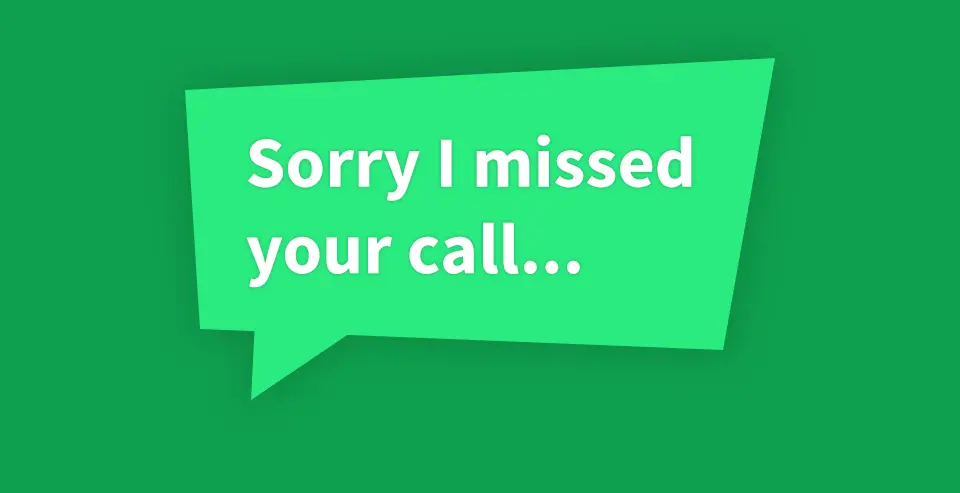Are you on the hunt for the perfect voicemail greeting but feeling a bit lost? Maybe the ones you’ve tried sound too laid-back, overly formal, or just don’t hit all the right notes you’re aiming for. Well, you’re in luck!
In this quick guide, we’re diving deep into the art of crafting a professional business voicemail that resonates. Whether it’s the cheerful hello or the promise to return the call, every detail matters in making that first impression count.
For countless professionals and businesses, your voicemail message is the front door to your service, often the customer’s first interaction with you. So, your voicemail mustn’t just sound good, but it feels welcoming and professional, assuring every caller they’ve come to the right place.
Before you press record, let’s walk through some insider tips to elevate your voicemail game. From striking the perfect tone to nailing the content, we’re here to ensure your voicemail greeting leaves a lasting, positive impression.
Or, you can just jump straight to our 24 professional voicemail examples.
1. The Basics of a Professional Voicemail Greeting
Crafting the perfect professional voicemail greeting is a lot like making a great first impression at a networking event. You want to come across as warm, welcoming, and efficient, all without the benefit of a face-to-face interaction.
The key is in the tone of your voice, the clarity of your message, and the brevity of your words. Think of your voicemail as a concise pitch about who you are and what you do, designed to inform and reassure your caller that they’ve come to the right place and will be taken care of.
A great greeting is the cornerstone of effective communication with your clients, partners, or anyone else who might call. It’s your first opportunity to convey professionalism, personality, and the essence of your brand’s customer service philosophy.
By getting it right, you ensure that every caller knows they’re valued from the moment they hear your voice.
Below are five key elements to include in your voicemail greeting:
- Start with a smile: Your smile comes through in your voice, setting a positive tone.
- Introduce yourself and your company: Make sure they know who you are and that they’ve reached the right place.
- Thank them for calling: A simple thank you can make a big difference in how your message is received.
- Express regret for missing their call: It shows you value their attempt to reach out.
- Provide a clear next step: Tell them exactly what to do next, ensuring a seamless experience.
2. Customizing Your Message for Your Audience
When it comes to voicemail greetings, one size does not fit all. The most effective messages are those tailored to the specific audience you serve. This customization makes your message more relevant and engaging, whether you’re a lawyer speaking to clients, a local bakery to your customers, or a tech startup to your investors.
By considering who is most likely to call and why they’re calling, you can craft a greeting that resonates, reassures, and guides them to the next step in their journey with you.
Personalizing your voicemail doesn’t just show that you understand your audience; it also sets the stage for the kind of relationship you want to build with them. It’s an opportunity to demonstrate your business’s values, whether that’s reliability, creativity, or care.
It’s about making every caller feel like they’re not just reaching a business but a partner or provider who genuinely wants to hear from them and meet their needs.
Here’s how to make your voicemail greeting feel like a warm, personalized welcome mat for your callers:
- Know who’s calling: Tailor your tone and message based on whether your audience is formal, casual, or somewhere in between.
- Mention what you do: Give a quick insight into your services or mission to remind callers why they reached out to you.
- Use language they understand: Avoid industry jargon unless it’s common knowledge for your audience.
- Add a personal touch: Let your unique personality or brand voice shine.
- Update for seasons or events: Keep your message fresh and relevant to show you’re actively engaged with your business and clients.
3. Common Voicemail Mistakes to Avoid
We’ve all encountered voicemails that leave us feeling lost, frustrated, or wanting to hang up. These are often the result of well-intentioned attempts at professionalism that miss the mark. Avoiding common pitfalls is crucial for maintaining professionalism and ensuring your voicemail greeting enhances, rather than detracts from, your caller’s experience.
From overly long messages that test patience to background noise that distracts, these mistakes can easily undermine the professionalism and clarity you’re aiming for.
Remember, your voicemail greeting is integral to your business’s communication strategy. It should be given the same attention to detail as any other aspect of your customer service or marketing efforts.
By avoiding common errors, you can create a voicemail greeting that effectively represents your business and respects your caller’s time and needs.
Below are five common business voicemail message mistakes to watch out for:
- Going on and on: Keep your message concise to respect your caller’s time.
- Sounding like a robot: Inject your personality to make the greeting more engaging.
- Being vague about callback times: Offer a clear expectation for when you’ll return their call.
- Forgetting to update your message: Ensure your greeting is always current and relevant.
- Neglecting background noise: Record in a quiet space to maintain professionalism and clarity.
4. Business Voicemail Greeting Examples
Feeling overwhelmed by the thought of distilling your professional essence into a succinct, 20-second voicemail? Let’s take a deep breath together — it’s easier than it seems, we promise.
There’s a fine line between overthinking and perfectly crafting your message. To help steer you away from analysis paralysis and towards clarity and confidence, we’ve curated a selection of voicemail greeting examples just for you.
As you explore these examples, remember: the impact of your voicemail greeting hinges less on the exact words you choose and more on the tone and sincerity with which you deliver them.
Aim for a balance of cheerfulness and warmth, underscored by undeniable professionalism.
So, before you hit the record button on your professional voicemail message, let’s dive into these examples. They’re here to spark your creativity and guide you toward creating a greeting that resonates with your callers and perfectly represents your brand.
Here are 24 professional business voicemail greeting examples:
Example 1:
“Thank you for calling. You have reached (Your Name) at (Your Business). Please leave your name, number, and a brief message, and I’ll return your call as soon as possible.”
Example 2:
“You have reached (Your Name) at (Your Business). I’m sorry that I wasn’t able to get to the phone. If you leave your name and number, I’ll return your call within one business day.“
Example 3:
“Thank you for calling (Your Name) at (Your Business), where (What You Do). I’m sorry that I was unable to take your call. Please leave me your name, number, and a quick message, and I’ll call you back shortly.”
Example 4:
“You have reached (Your Name) at (Your Business). We help (What Your Business Does). I can’t take your call right now, but leave your name and number, and I’ll get back to you as soon as possible.”
Example 5:
“You have reached (Your Name) at (Your Business). I could not take your call, but if you leave a brief message, I’ll call you back as soon as possible.”
Example 6:
“Hello, and thank you for calling [Your Business Name], where we specialize in [Brief Description of Services]. Unfortunately, I can’t take your call right now, but your call is important to us. Please leave your name, contact information, and the reason for your call, and I promise to get back to you within 24 hours. Thank you, and have a great day.”
Example 7:
“Hi, you’ve reached [Your Name] at [Your Business Name]. I’m currently on the other line or away from my desk. Please leave your name, number, and a detailed message after the beep, and I’ll ensure I return your call promptly. Thank you for reaching out.”
Example 8:
“Good [Morning/Afternoon/Evening], you’ve connected with [Your Name] of [Your Business Name]. Your call is important to me, but I can’t answer now. Please leave your name, message, and the best number to reach you at, and I will contact you at my earliest convenience. I appreciate your understanding.”
Example 9:
“Thank you for calling [Your Business Name], your trusted partner in [Business Specialty]. Unfortunately, all our representatives are currently assisting other customers. Please leave your name, contact number, and a brief message, and one of our team members will get back to you as soon as possible. We appreciate your patience and look forward to speaking with you.”
Example 10:
“Hello, you’ve reached the voicemail of [Your Name], [Your Position] at [Your Business Name]. I am currently unavailable to take your call. Please leave your contact details and a brief overview of how we can assist you, and I’ll make sure to return your call by the next business day. Thank you for calling, and we value your interest in our services.”
Example 11:
“Hello! You’ve dialed into [Your Business Name], where we excel in [Service/Product Offered]. I’m [Your Name], and unfortunately, I can’t take your call at the moment. Please leave your details and the nature of your inquiry, and I’ll ensure to follow up with you directly. Your interest is very important to us. Thank you!”
Example 12:
“Thank you for calling [Your Business Name]. This is [Your Name]. I’m currently either on a call or out of the office. Please leave your name, contact number, and a short message. I guarantee a return call by the next working day. Your business matters to us.”
Example 13:
“Hi, this is [Your Name] from [Your Business Name], where we’re passionate about [Business’s Mission/Values]. I’m unavailable right now, but I’m keen to connect with you. Leave your name, number, and message, and I’ll reach out to you the moment I’m free. I appreciate your understanding.”
Example 14:
“Good day! You’ve reached [Your Business Name], and I’m [Your Name], [Your Position]. Currently away from my desk or on another call, I’m unable to answer your call personally. Please leave a message with your contact details, and I promise to get back to you promptly. Your call is very important to us.”
Example 15:
“You’ve reached [Your Name] at [Your Business Name], where quality and customer service come first. I’m sorry to miss your call. Please leave your name, a brief message, and the best way to reach you, and I’ll be in touch as soon as possible. Thank you for your call.”
Example 16:
“Hello, and thank you for calling [Your Business Name]. This is [Your Name], and I’m currently in a meeting or on the phone with another client. Your call is important, so please leave your name, number, and a detailed message. I’ll get back to you as soon as possible. Have a great day!”
Example 17:
“Hi! You’ve reached the voicemail of [Your Name], [Your Position] at [Your Business Name]. Unfortunately, I can’t answer your call right now. Please leave your information and how I can assist you, and I’ll call back as soon as I’m available. Your patience is appreciated.”
Example 18:
“You have reached [Your Business Name], where we provide [Description of Services]. I’m [Your Name], and I’m currently away from the phone. Leave your details and your query, and I’ll ensure to return your call with all the information you need. Thank you for reaching out.”
Example 19:
“Thank you for calling [Your Business Name]. This is [Your Name]. I’m currently attending to other matters and unable to take your call. Please leave your name, message, and the best contact number, and I will get back to you as quickly as possible. Your call is important to us.”
Example 20:
“Hello! You’ve reached [Your Name] of [Your Business Name], where we specialize in [Your Specialty]. I’m not available to take your call at the moment, but please leave me a message with your name and number, and I’ll be sure to return your call. I appreciate your understanding.”
Example 21:
“This is [Your Name] from [Your Business Name], your go-to source for [Your Services/Products]. I can’t answer your call right now, but don’t hesitate to leave your name, number, and message after the tone. I’ll get back to you as swiftly as possible. Thanks for calling!”
Example 22:
“Hi, you’ve called [Your Name] at [Your Business Name]. I’m away from my desk or on another call at the moment. Please leave your name, contact information, and a brief message, and I’ll return your call at my first opportunity. I appreciate your patience!”
Example 23:
“[Your Business Name] thanks you for your call. [Your Name] here, but I’m currently unable to take your call. Your message is important to me, so please leave your name, number, and a brief message, and I’ll call you back as soon as possible. Have a wonderful day!”
Example 24:
“Hello, and thank you for calling [Your Business Name], where we strive for excellence in [Your Field]. Unfortunately, [Your Name] is unavailable to take your call. Please leave your name, contact number, and the reason for your call, and I’ll contact you at my earliest convenience. Thank you for your patience and understanding.”
5. Give It a Shot
Remember, your voicemail greeting is more than just a message; it’s an opportunity to connect, reassure, and set the tone for the customer experience. By infusing your greeting with warmth, clarity, and a touch of your brand’s essence, you create a welcoming entry point into your business that speaks volumes to callers, even in your absence.
So, take a moment to review your current voicemail greeting. Does it convey the message you want? Is it clear, concise, and inviting? If not, it might be time to hit the record button again, keeping in mind the tips and tricks you’ve just learned.
With a little effort and creativity, your voicemail can become one of your strongest tools in building trust and rapport with your customers and partners.
Editor’s Note: The article is part of the blog series Grow Your Business by the marketing team at Unitel, the virtual phone system priced and designed for startups and small business owners.






